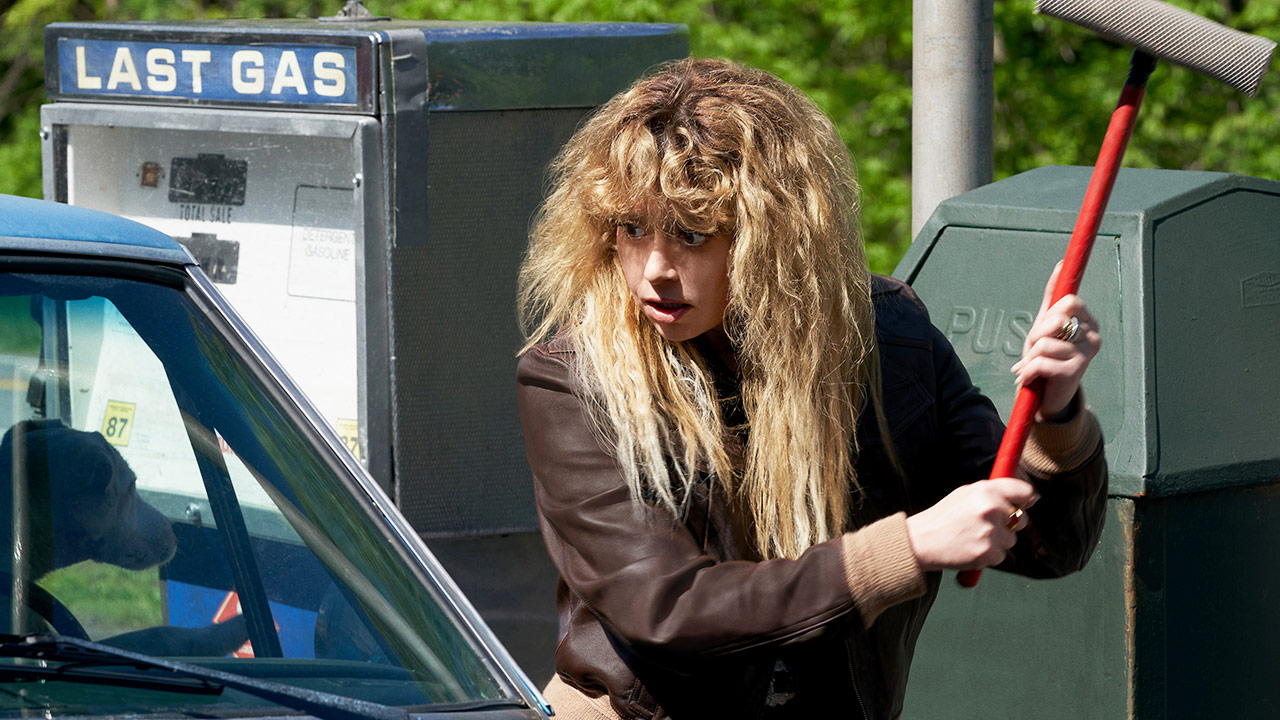Natasha Lyonne brings style and sass to reverse whodunit series Poker Face

Knives Out director Rian Johnson helms another smart and playful murder mystery with this addictive genre-reinvigorating series, writes Luke Buckmaster.
Fans of Netflix’s time-tripping comedy-drama Russian Doll won’t be surprised to learn that its star, Natasha Lyonne, brings style, sass and a big bird-flipping personality to Rian Johnson’s new murder mystery series. Nor will fans of the Knives Out movies be surprised to discover Johnson taking a playful approach. In Poker Face, the auteur (the show’s creator, executive producer, co-writer, and director of the first, second and ninth episodes) uses a reverse whodunit format, whereby viewers enter self-contained narratives knowing more than the detective. Like in Columbo, this provides a comforting counter to many instances in which smug sleuths—your Benoit Blancs, Hercule Poirots and Jessica Fletchers of the world—remain annoying ahead of the eight ball.
Lyonne’s character, Charlie Cale, is also very different to your standard gumshoe—a heavy drinking, trash-talking bad ass more at home in a mosh pit than a library. Her shtick is “that shit ain’t cool” rather than “justice will be served.” Each episode begins with the introduction of new characters: one of whom will be the murderer, another the victim. The plot then reverses in time to reveal how Charlie came to know the deceased person, establishing a motivation for her to avenge their death by exposing the culprit.
Most TV detectives have a pretty good bullshit detector, but Charlie’s is next level—this aspect of her character reflecting the show’s core novelty. Like the twist involving Ana de Armas’ character in Knives Out, who can’t help but vomit every time she lies, it sounds ridiculous but is treated matter-of-factly in the narrative universe: Charlie knows every time someone’s lying. It’s like a sixth sense, and she’s never wrong.
The closest we get to an explanation occurs in the first episode, when the protagonist is working as a cocktail waitress in a casino and is summoned to the office of Adrien Brody’s Sterling Frost Jr. Assuming she’s there to be fired, Charlie instead finds herself on the receiving end of a monologue in which the boss reveals he knows her past as a gambler who “played with an almost supernatural infallibility, like she was seeing through the cards.” Sterling explains that his magnate father studied Charlie for days, and “even when he figured it out he couldn’t believe it…but there was no other explanation.” Their interaction includes the following exchange:
Sterling: It’s not like it’s one thing, like my eye twitches or somethin’?
Charlie: Nah.
Sterling: It’s just a general…
Charlie: Yeah.
Sterling: You can just tell.
Charlie: Just that something is off. That’s the best way to describe it. I can just tell.

None of the culprits past the first episode know that Charlie knows when they’re lying. But the audience does, so when Charlie says “bullshit” (or words to that effect) we understand it’s not a throwaway line but statement of an incontrovertible fact. Another interesting aspect of her character is her motivations, or lack thereof. Rather than being driven by a desire to put her special ability to good use, Charlie is a reluctant hero, content with her modest existence—“I like my life, I like my job”, she tells Sterling—but dragged by the casino boss into chaotic (albeit ultimately heroic) exploits.
As I smashed through the first six episodes, I was reminded of an argument expressed by film scholar Howard Suber in his influential book The Power of Film. Suber argued that “there is no such thing as an antihero. There are only characters who act heroically and those who do not.” The author introduces his argument by drawing on the example of a Good Samaritan driving home from work, who sees a house on fire then “rushes in and rescues an elderly lady.” This person has acted heroically but does not go looking for a chance to be a hero.
Nor does Charlie go looking for cases to solve or murderers to catch. Like many screen detectives, wherever she goes, death follows—making her a character you kind of want to party with, but also feel inclined to stay several suburbs away from.

Press coverage of Poker Face has splashed about the term “howdunit,” a murder mystery mode that emphasises details of a crime rather than the perpetrator. But it’s not quite right to say the show has no element of a whodunit. The first 10 or so minutes of every episode present both a whodunit and a whowillbedun, the writers relishing a small window in which the killer and victim are yet to be revealed. In episode two, for instance, we’re unsure whether the murderer is going to be a Subway employee or a young grease monkey.
This context-setting playfulness gets deliciously entertaining in the sixth episode, which opens by introducing two ageing actors who hate each other’s guts, both of whom appear to be making plans to kill the other. What happens will take you by surprise—and that’s before Charlie even arrives on the scene.
One can imagine this format (including that core novelty) being milked to death, which is almost a rite of passage for successful murder mystery shows. Columbo ran for nine seasons (plus more than 10 specials); Death in Paradise has hit 12 (and counting); and Murder, She Wrote totaled four movies and 12 seasons, hitting a whopping 264 episodes. It’s hard to imagine Poker Face going that far—but let’s hope, come the end of season one, there’s plenty of gas left in the tank. So far it’s a shrewd, moreish pleasure—and among the most interesting reinventions of the murder mystery genre in years.


















